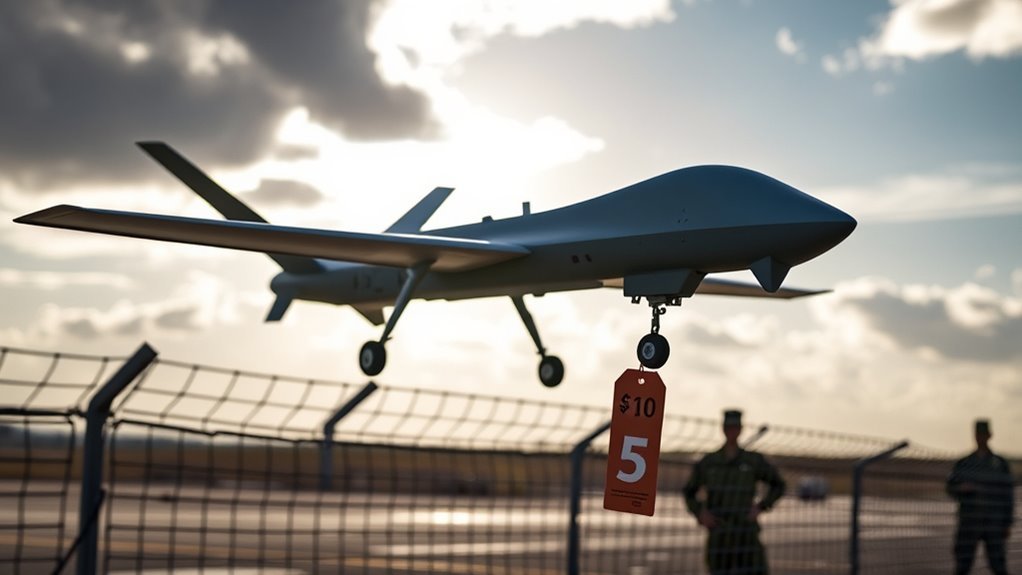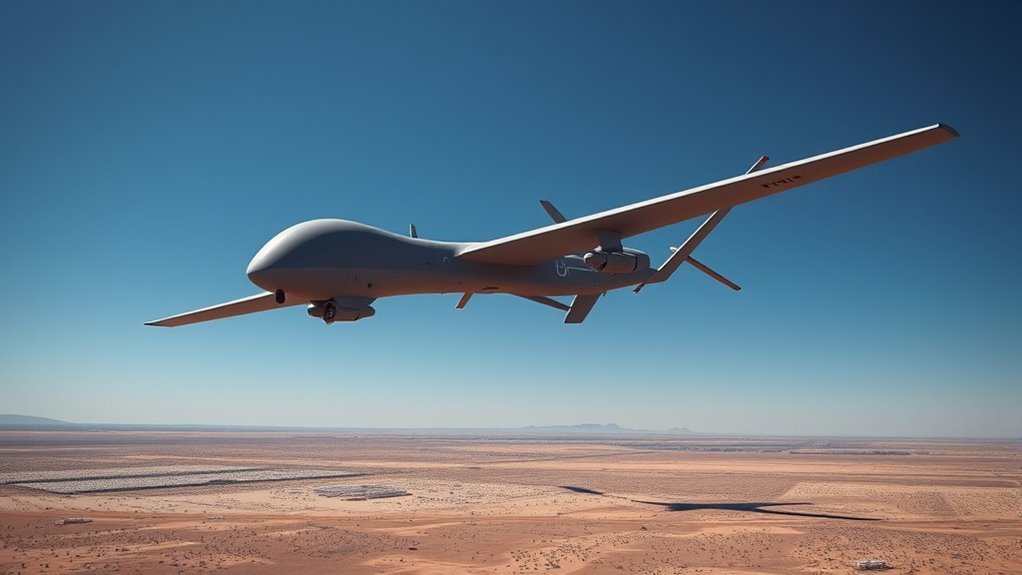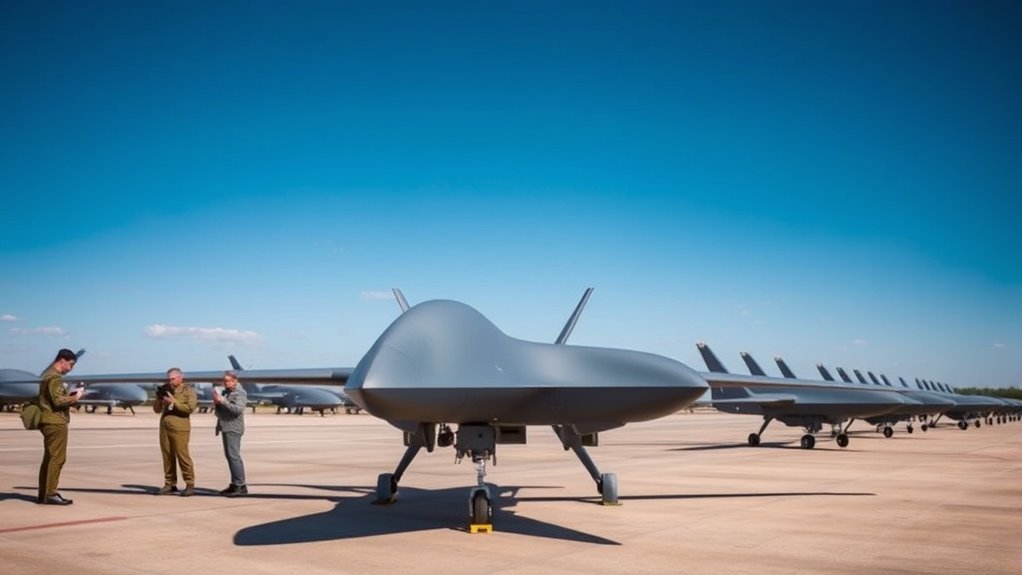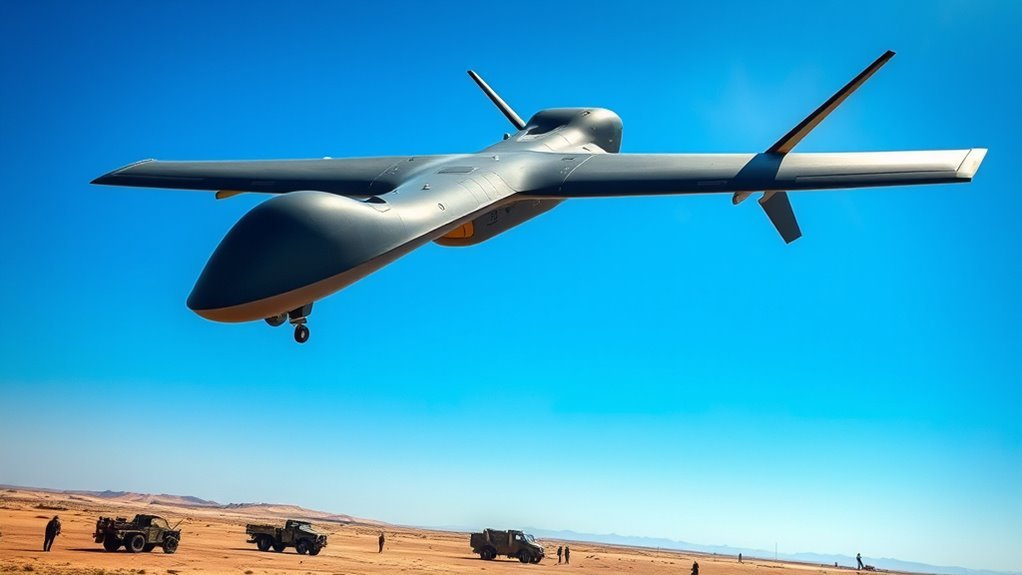Military drones vary considerably in cost based on their type and capabilities. Smaller tactical drones can be as low as $10,000, while sophisticated models like the MQ-9 Reaper may exceed $16 million. Prices are influenced by factors such as technology advancements, scale of production, and intended mission profiles. Ongoing maintenance and support also factor into long-term costs. For a clearer understanding of the pricing landscape and additional insights, further exploration of the topic is recommended.
Types of Military Drones and Their Costs

When considering the landscape of military drones, it is essential to recognize that various types serve distinct operational purposes, each accompanied by different cost structures. For example, drones specializing in reconnaissance capabilities often emphasize surveillance technology over payload capacities, making them more affordable. Conversely, armed drones, designed for combat and support missions, typically integrate advanced systems for targeting and weaponry, leading to higher costs. Additionally, the balance between operational range and endurance can greatly influence pricing. You’ll find that smaller tactical drones may be more cost-effective, while larger unmanned aerial vehicles (UAVs) equipped with robust sensors and weapon systems can demand substantial investments. Understanding these variances helps clarify the financial implications of military drone acquisition.
Factors Influencing Drone Pricing

The pricing of military drones is influenced by a variety of factors that extend beyond their basic type and function. First, advancements in drone technology play a vital role; more sophisticated systems with enhanced capabilities typically come at a higher cost. Additionally, the scale of production affects pricing strategies; bulk orders can lower costs through economies of scale. Regulatory compliance and the need for extensive testing and certification also add to the overall expenses. Furthermore, the intended mission profile dictates specific features, further influencing costs. For instance, AI capabilities can significantly enhance a drone’s effectiveness in surveillance tasks. Finally, ongoing maintenance and support requirements must be factored in, as they can greatly impact the total lifecycle cost of the drone. Understanding these elements is essential for evaluating the true financial commitment involved in military drones. Furthermore, automated spray control in agricultural applications showcases how advanced technology can also drive innovation in drone capabilities.
Cost Comparisons of Different UAV Models

Cost comparisons among different UAV models reveal significant variations that can impact military budgeting decisions. When evaluating drone technology, it’s essential to take into account the price range of various models. For instance, small tactical drones may cost as little as $10,000, while larger, more sophisticated systems like the MQ-9 Reaper can exceed $16 million. These differences necessitate careful budget allocations, as investing in advanced UAVs might yield better intelligence and operational advantages. However, the upfront costs must align with long-term strategic goals. Understanding these financial implications helps military planners make informed decisions, ensuring that resources are utilized effectively while maintaining operational readiness. Therefore, a thorough analysis of UAV costs is vital for optimizing defense spending. Additionally, the advanced camera capabilities of military drones can significantly enhance surveillance and reconnaissance missions.
Maintenance and Operational Expenses
While acquiring military drones involves significant initial investment, ongoing maintenance and operational expenses can substantially affect the overall budget. Proper drone upkeep is essential to guarantee reliability and efficiency. These costs can be categorized as follows:
Acquiring military drones requires significant investment, but ongoing maintenance is crucial for ensuring reliability and managing budgets effectively.
- Routine inspections and repairs: Regular check-ups are necessary to maintain airworthiness.
- Replacement parts: Wear and tear can lead to costly replacements of components.
- Training personnel: Skilled operators and technicians are important for effective drone management.
- Fuel and software updates: Keeping drones operational requires fuel and the latest software for peak performance.
Understanding these expenses is critical for managing operational budgets. By planning for these ongoing costs, you can ensure that your investment in military drones remains sustainable and effective.
The Value of Military Drones in Combat and Surveillance
Investing in military drones not only involves initial and ongoing costs but also provides significant operational advantages in combat and surveillance scenarios. Drones enhance combat efficiency by delivering precise targeting and minimizing risks to personnel. They can conduct missions in high-threat environments while remaining out of harm’s way, allowing for strategic advantages. Additionally, their surveillance capabilities are unparalleled; drones can gather real-time intelligence over vast areas, enabling quicker decision-making. This capability enhances situational awareness, allowing forces to respond to threats more effectively. Ultimately, the integration of military drones into operations not only streamlines processes but also empowers your forces to maintain a tactical edge, ensuring greater success in achieving mission objectives without sacrificing safety.
Frequently Asked Questions
Can Civilians Purchase Military Drones for Personal Use?
Civilians can’t typically purchase military drones due to strict regulations governing their ownership. While civilian drone ownership is generally permitted, military-grade technology often falls under export controls, limiting access to such advanced equipment for personal use.
How Are Military Drones Funded by Governments?
Government budgets are like colossal rivers, endlessly flowing into defense contracts. They fund military drones through a meticulous process, ensuring taxpayer money supports advanced technology for national security, balancing innovation with public accountability in the process.
What Is the Lifespan of a Military Drone?
The operational lifespan of a military drone largely depends on its design and usage. Generally, you’ll find that drone durability can range from several years to over a decade, influenced by maintenance and technological advancements.
Are There Restrictions on Military Drone Usage?
You might recall the debates surrounding surveillance and privacy; similarly, military applications of drones face strict drone regulations. These restrictions aim to balance national security interests with ethical considerations and civilian safety, fostering responsible usage.
How Do Military Drones Compare to Commercial Drones?
When comparing military drones to commercial ones, you’ll find military capabilities often far exceed typical drone technology. Military drones are designed for specific missions, enhancing surveillance and combat effectiveness, while commercial drones focus on consumer applications.

